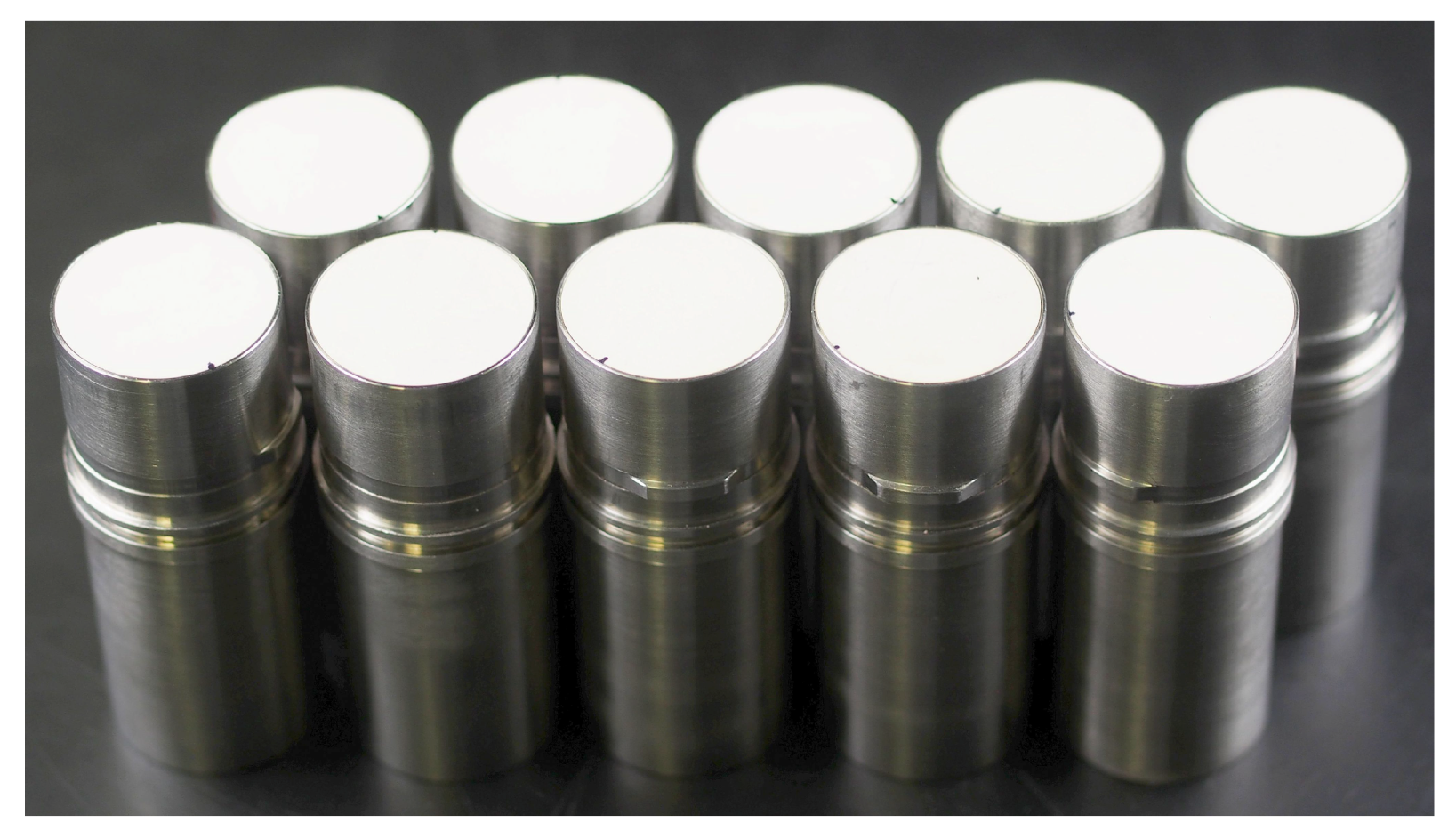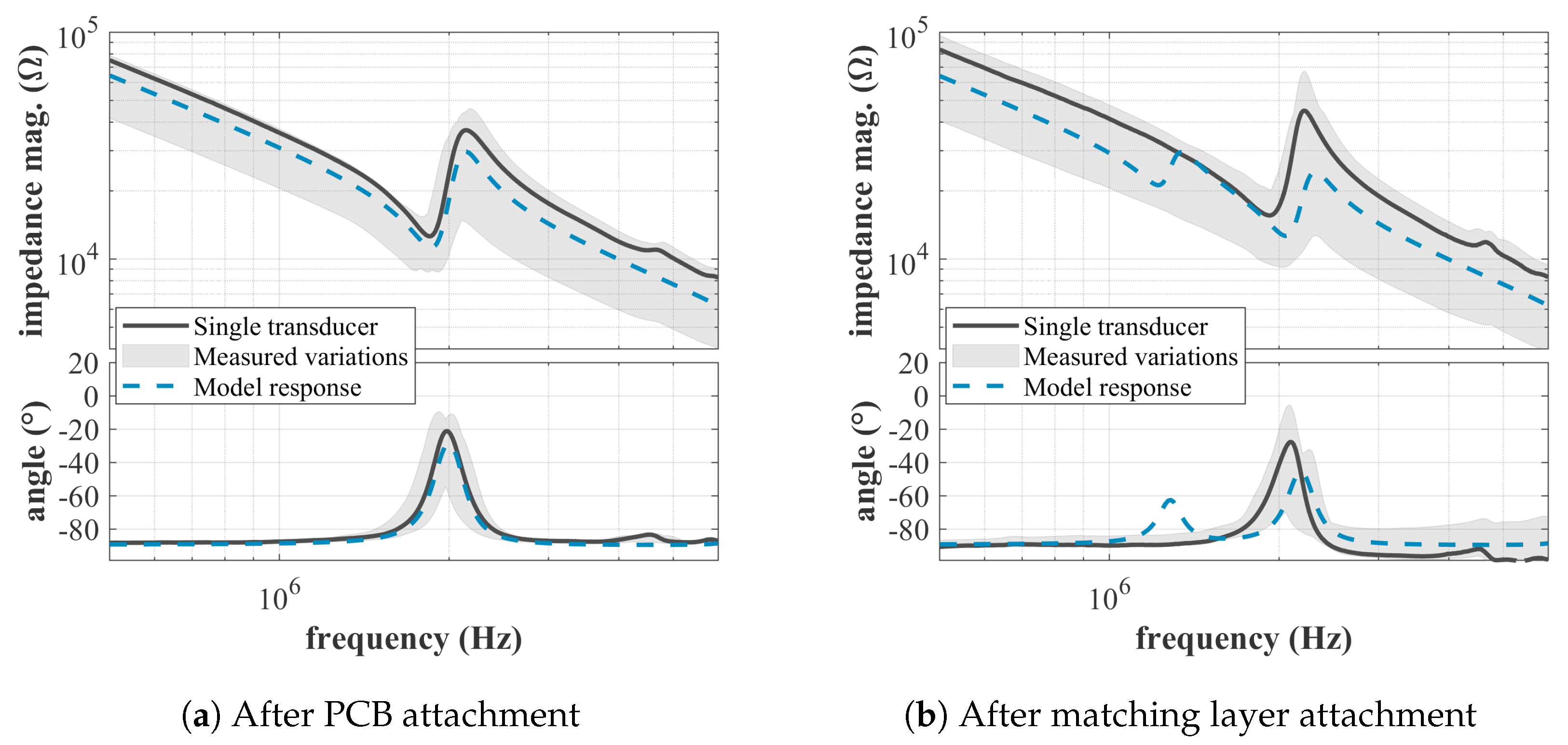Model-Guided Manufacturing of Transducer Arrays Based on Single-Fibre Piezocomposites
Abstract
:1. Introduction
2. Materials and Methods
2.1. Overview
2.2. PZT Fibre Disc
2.3. Transducer Assembly
2.4. Transducer Model
2.5. Initial Model Fit
- The series resonance of the thickness resonator resonance.
- The EMI magnitude at .
- The approximated parallel capacitance , calculated at 500 kHz. With phase angles close to −90, the transducers behave almost purely capacitive at this frequency.
- The maximum phase angle of the thickness resonator resonance.
3. Results
3.1. Model Predictions
3.2. Assembly Analysis
3.3. Quality Control
4. Discussion
Author Contributions
Funding
Acknowledgments
Conflicts of Interest
Abbreviations
| EMI | Electro-mechanical impedance |
| KLM | Transducer network model developed by R. Krimholtz, D. Leedom and G. Matthaei |
| PZT fibre disc | Single-fibre piezocomposite disc array |
| PCB | Printed circuit board |
| PZT | Lead zirconium titanate |
| ROC | Receiver operating characteristic curve |
| TAS | Transducer array system |
| TMM4 | Thermoset microwave material, Rogers Corp. |
| USCT | Ultrasound computer tomography |
Appendix A. KLM Model

Appendix B. Model Parameters
| Parameter | Unit | Initial Step | Optimised |
|---|---|---|---|
| 770 | 770 | ||
| 450 | 450 | ||
| − | |||
| − | 1880 | 1880 | |
| 130 | |||
| − | |||
| Parameter | Unit | Final Step | Optimised |
|---|---|---|---|
| 60 | 60 | ||
| 298 | 298 | ||
| 2640 | 2640 | ||
| 430 | 430 | ||
| 157 | 471 * | ||
| 3280 | 3280 | ||
| 50 | 50 | ||
| 631 | 631 | ||
| 1700 | 1700 | ||
References
- Wellings, E.; Vassiliades, L.; Abdalla, R. Breast Cancer Screening for High-Risk Patients of Different Ages and Risk—Which Modality Is Most Effective? Cureus 2016, 8, e945. [Google Scholar] [CrossRef] [PubMed] [Green Version]
- Freer, P.E. Mammographic Breast Density: Impact on Breast Cancer Risk and Implications for Screening. RadioGraphics 2015, 35, 302–315. [Google Scholar] [CrossRef] [PubMed]
- Calderon, C.; Vilkomerson, D.; Mezrich, R.; Etzold, K.F.; Kingsley, B.; Haskin, M. Differences in the attenuation of ultrasound by normal, benign, and malignant breast tissue. J. Clin. Ultrasound 1976, 4, 249–254. [Google Scholar] [CrossRef] [PubMed]
- Johnson, S.A.; Abbott, T.; Bell, R.; Berggren, M.; Borup, D.; Robinson, D.; Wiskin, J.; Olsen, S.; Hanover, B. Non-Invasive Breast Tissue Characterization Using Ultrasound Speed and Attenuation. In Acoustical Imaging; Springer: Dordrecht, The Netherlands, 2007; pp. 147–154. [Google Scholar]
- Greenleaf, J.F. Three-dimensional Imaging in Ultrasound. J. Med. Syst. 1982, 6, 579–589. [Google Scholar] [CrossRef] [PubMed]
- Ruiter, N.V.; Göbel, G.; Berger, L.; Zapf, M.; Gemmeke, H. Realization of an Optimized 3D USCT. Proc. SPIE Med. Imaging 2011, 7961–7968. [Google Scholar] [CrossRef]
- Ruiter, N.V.; Schwarzenberg, G.F.; Zapf, M.; Gemmeke, H. Conclusions from an experimental 3D Ultrasound Computer Tomograph. IEEE Nucl. Sci. Symp. Conf. Rec. 2008, 4502–4509. [Google Scholar] [CrossRef]
- Gemmeke, H.; Ruiter, N.V. 3D Ultrasound Computer Tomography for Medical Imaging. Nucl. Instrum. Methods Phys. Res. Sect. Accel. Spectrom. Detect. Assoc. Equip. 2007, 580, 1057–1065. [Google Scholar] [CrossRef]
- Ruiter, N.; Zapf, M.; Dapp, R.; Hopp, T.; Kaiser, W.A.; Gemmeke, H. First Results of a Clinical Study with 3D Ultrasound Computer Tomography. IEEE Int. Ultrason. Symp. 2013, 651–654. [Google Scholar] [CrossRef]
- Zapf, M.; Hohlfeld, K.; Ruiter, N.V.; Pfistner, P.; van Dongen, K.; Gemmeke, H.; Michaelis, A.; Gebhardt, S.E. Development of Single-Fiber Piezocomposite Transducers for 3-D Ultrasound Computer Tomography. Adv. Eng. Mater. 2018, 20, 1800423. [Google Scholar] [CrossRef]
- Günther, P.A.; Neumeister, P.; Neubert, H.; Gebhardt, S. Development of 40-MHz Ultrasonic Transducers via Soft Mold Process. IEEE Trans. Ultrason. Ferroelectr. Freq. Control 2019, 66, 1497–1503. [Google Scholar] [CrossRef] [PubMed]
- Safari, A.; Janas, V.F.; Bandyopadhyay, A. Development of fine-scale piezoelectric composites for transducers. AIChE 1997, 43 (Suppl. 11), 2849–2856. [Google Scholar] [CrossRef]
- Gebhardt, S.E.; Hohlfeld, K.; Günther, P.; Neubert, H. Manufacturing Technologies for Ultrasonic Transducers in a Broad Frequency Range. In Proceedings of the International Workshop on Medical Ultrasound Tomography, Speyer, Germany, 1–3 November 2017; pp. 147–158. [Google Scholar]
- Park, G.; Inman, D.J. Structural Health Monitoring using Piezoelectric Impedance Measurements. Philos. Trans. R. Soc. Math. Phys. Eng. Sci. 2007, 365, 373–392. [Google Scholar] [CrossRef] [PubMed]
- Cochran, S.; Demore, C.; Courtney, C. Modelling Ultrasonic-Transducer Performance: One-Dimensional Models; Woodhead Publishing: Cambridge, UK, 2012; pp. 187–219. [Google Scholar] [CrossRef]
- Krimholtz, R.; Leedom, D.A.; Matthaei, G.L. New Equivalent Circuits for Elementary Piezoelectric Transducers. Electron. Lett. 1970, 6, 2. [Google Scholar]
- Zapf, M.; Pfistner, P.; Liberman, C.I.; van Dongen, K.; Jong, N.d.; Leyrer, B.; Gemmeke, H.; Ruiter, N.V. Dice-and-fill single element octagon transducers for next generation 3D USCT. In Proceedings of the International Workshop on Medical Ultrasound Tomography, Speyer, Germany, 1–3 November 2017; pp. 159–177. [Google Scholar] [CrossRef]
- Kohout, B. Simulation, Analyse und Entwurf eines 3D Ultraschall-Computertomographen für Diagnose und Therapie. (German) [Simulation, Analysis and design of a 3D Ultrasound-Tomograph for Diagnosis and Therapy]. Ph.D. Thesis, Karlsruhe Institute of Technology, Karlsruhe, Germany, 2014. [Google Scholar]
- Gemmeke, H.; Berger, L.; Hopp, T.; Zapf, M.; Tan, W.; Blanco, R.; Leys, R.; Peric, I.; Ruiter, N.V. The New Generation of the KIT 3D USCT. In Proceedings of the International Workshop on Medical Ultrasound Tomography, Speyer, Germany, 1–3 November 2017; pp. 271–281. [Google Scholar]
- Hohlfeld, K.; Gebhardt, S.; Schönecker, A.; Michaelis, A. PZT components derived from polysulphone spinning process. Adv. Appl. Ceram. 2015, 114, 231–237. [Google Scholar] [CrossRef]
- Birk, L. Aufbau und Charakterisierung einer Serie von Ultraschallwandlern fuer einen Ultraschall Computertomographen. (German) [Manufacturing and Characterization of a series of Ultrasound Transducers for Ultrasound Computer Tomography]. Master’s Thesis, Karlsruhe Institute of Technology, Karlsruhe, Germany, 2019. [Google Scholar]
- Desilets, C.S.; Fraser, J.D.; Kino, G.S. The design of efficient broad-band piezoelectric transducers. IEEE Trans. Sonics Ultrason. 1978, 25, 115–125. [Google Scholar] [CrossRef]
- Castillo, M.; Acevedo, P.; Moreno, E. KLM model for lossy piezoelectric transducers. Ultrasonics 2003, 41, 671–679. [Google Scholar] [CrossRef]
- Van Kervel, S.J.H.; Thijssen, J.M. A calculation scheme for the optimum design of ultrasonic transducers. Ultrasonics 1983, 21, 134–140. [Google Scholar] [CrossRef]
- Selfridge, A.R. Approximate Material Properties in Isotropic Materials. IEEE Trans. Sonics Ultrason. 1985, 32, 381–394. [Google Scholar] [CrossRef]
- Wang, H.; Ritter, T.A.; Cao, W.; Shung, K.K. Passive Materials for High-Frequency Ultrasound Transducers. Proc. SPIE Med. Imaging 1999, 3664, 35–42. [Google Scholar] [CrossRef]
- Chevallier, G.; Ghorbel, S.; Benjeddou, A. A benchmark for free vibration and effective coupling of thick piezoelectric smart structures. Smart Mater. Struct. 2008, 17, 065007. [Google Scholar] [CrossRef]
- Fawcett, T. ROC Graphs: Notes and Practical Considerations for Researchers. Mach. Learn. 2004, 31, 1–38. [Google Scholar]
- Jain, A.K.; Murty, M.N.; Flynn, P.J. Data clustering. ACM Comput. Surv. 1999, 31. [Google Scholar] [CrossRef]
- Lenk, A.; Ballas, R.; Werthschützky, R.; Pfeifer, G. Electromechanical Systems in Microtechnology and Mechatronics; Springer: Berlin/Heidelberg, Germany, 2011. [Google Scholar] [CrossRef]













| Assembly | ||||||||
|---|---|---|---|---|---|---|---|---|
| Step | meas. | mod. | meas. | mod. | meas. | mod. | meas. | mod. |
| (1) Initial | ||||||||
| (2) PCB | ||||||||
| (3) Matching L. | ||||||||
| (4) Final | ||||||||
© 2020 by the authors. Licensee MDPI, Basel, Switzerland. This article is an open access article distributed under the terms and conditions of the Creative Commons Attribution (CC BY) license (http://creativecommons.org/licenses/by/4.0/).
Share and Cite
Angerer, M.; Zapf, M.; Leyrer, B.; Ruiter, N.V. Model-Guided Manufacturing of Transducer Arrays Based on Single-Fibre Piezocomposites. Appl. Sci. 2020, 10, 4927. https://doi.org/10.3390/app10144927
Angerer M, Zapf M, Leyrer B, Ruiter NV. Model-Guided Manufacturing of Transducer Arrays Based on Single-Fibre Piezocomposites. Applied Sciences. 2020; 10(14):4927. https://doi.org/10.3390/app10144927
Chicago/Turabian StyleAngerer, Martin, Michael Zapf, Benjamin Leyrer, and Nicole V. Ruiter. 2020. "Model-Guided Manufacturing of Transducer Arrays Based on Single-Fibre Piezocomposites" Applied Sciences 10, no. 14: 4927. https://doi.org/10.3390/app10144927





